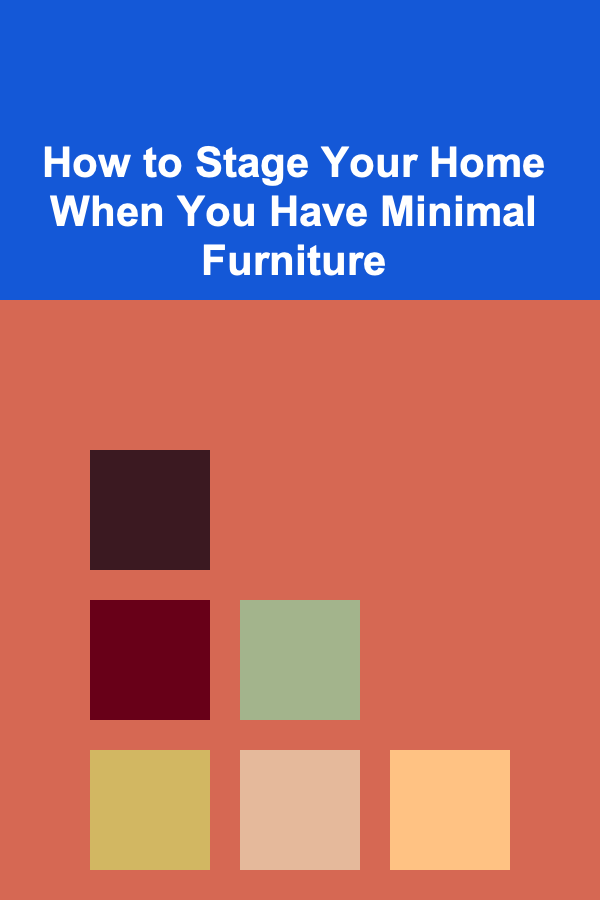
How to Block Outside Noise with DIY Soundproofing Tips
ebook include PDF & Audio bundle (Micro Guide)
$12.99$6.99
Limited Time Offer! Order within the next:

Noise pollution is one of the most common environmental stressors in modern life. Whether it's the hum of traffic, the chatter of neighbors, or the constant buzz of city life, unwanted sound can infiltrate your home, disturb your peace, and even affect your mental and physical health. This makes blocking outside noise a priority for anyone looking for a more serene and comfortable living environment.
The good news is that soundproofing doesn't have to be an expensive or professional service. In fact, with a little creativity, effort, and the right materials, you can easily block out noise using DIY methods. In this article, we'll explore various techniques and tips that will help you soundproof your space and create a quieter, more peaceful environment.
Understanding How Sound Travels
Before we dive into the methods of blocking outside noise, it's essential to understand how sound travels and why it can be so persistent.
Sound is a vibration that travels through the air and is perceived by our ears. When these sound waves encounter solid objects, they can either reflect, pass through, or be absorbed. In the case of external noise, sound waves travel through walls, windows, doors, and other openings. The goal of soundproofing is to prevent these vibrations from entering your living space.
Several factors influence how sound travels:
- Frequency: Low-frequency sounds (like bass from music or traffic) are harder to block because they have longer wavelengths, while high-frequency sounds (like human voices or birds chirping) are easier to block.
- Mass and Density: The denser and thicker a material is, the better it can block sound. This is why thick, heavy materials like concrete or brick are much more effective at blocking noise than thin materials like drywall.
- Sealing Gaps: Even the smallest cracks or gaps around doors and windows can allow sound to seep through, so sealing these openings is crucial for effective soundproofing.
Now that we have a basic understanding of sound's behavior, let's explore some practical DIY tips to block out outside noise.
Seal Gaps and Cracks
One of the most significant ways sound leaks into a room is through gaps around doors, windows, and even walls. Sealing these gaps effectively can reduce a large amount of noise from entering your living space.
How to Seal Gaps:
- Weatherstripping: Weatherstripping is an affordable and easy solution for sealing gaps around windows and doors. It comes in a variety of materials, including foam, rubber, and silicone, and can be applied directly to the door frame or window.
- Caulking: For cracks and gaps in walls or around windows, a high-quality acoustic caulk is a perfect solution. It remains flexible and can be applied easily with a caulk gun. Acoustic caulk helps fill in any small openings that could allow sound to pass through.
- Door Sweeps: These are strips of material that attach to the bottom of doors to block gaps between the door and the floor. They are especially effective for preventing noise from seeping in under doors.
Benefits:
Sealing gaps is one of the most effective ways to reduce noise pollution in your home. It's a simple, inexpensive step that prevents sound from entering through tiny openings.
Add Mass to Walls, Doors, and Windows
Soundproofing is all about blocking sound waves, and one of the most effective ways to do this is by adding mass to the surfaces that the sound is passing through. Heavier materials are much better at absorbing or blocking sound waves than lighter materials.
Methods for Adding Mass:
- Mass-Loaded Vinyl (MLV): MLV is a flexible, dense material that can be applied to walls, doors, or windows to significantly reduce sound transmission. It's an excellent option for DIY soundproofing because it's easy to install, and it adds significant mass to the area.
- Soundproofing Panels: Acoustic panels made of foam or fiberglass are another great option for adding mass to walls. These panels not only block sound but also help absorb sound within the room, preventing echo and reverberation. You can easily hang them on walls or install them on doors.
- Heavy Curtains: Thick, heavy curtains, especially those labeled as "soundproof," can block a significant amount of outside noise. The denser the fabric, the better it will block sound. Heavy curtains are especially effective for windows, which are often the primary source of noise intrusion.
Benefits:
Adding mass to walls and other surfaces can dramatically reduce the amount of sound that enters your space. This method is especially effective for dealing with low-frequency noise, like traffic or music.
Install Soundproof Windows
Windows are one of the most vulnerable parts of a house when it comes to noise infiltration. Single-pane windows, in particular, allow a lot of outside noise to enter your home. Fortunately, there are several DIY methods for improving the soundproofing of your windows.
DIY Window Soundproofing Tips:
- Window Inserts: One of the most cost-effective ways to soundproof windows is by using window inserts. These are additional layers of acrylic or glass that fit over your existing windows. They create an air gap between the window and the insert, which helps reduce sound transmission.
- Double Glazing: If you want to go further, consider adding a second layer of glass to your windows. Double-glazed windows consist of two panes of glass with a space between them, which helps block sound.
- Window Film: Some soundproofing window films can be applied directly to the glass to help absorb sound and reduce noise transmission. These films are easy to install and can also help with insulation, reducing both sound and heat transfer.
Benefits:
Soundproofing your windows can drastically reduce the amount of noise that enters from outside. This is particularly helpful in urban areas where traffic and other sounds are constant.
Use Acoustic Foam Panels
Acoustic foam panels are designed to absorb sound and reduce noise levels within a room. While they are often used in recording studios and music spaces, they can also be helpful in blocking outside noise.
How to Use Acoustic Foam Panels:
- Strategic Placement: Place foam panels on the walls where noise is most likely to enter. These panels can be mounted with adhesive or mounted on the wall using nails or screws.
- Soundproofing the Ceiling: In some cases, sound can enter through the ceiling, especially in apartment buildings. Acoustic foam panels can be installed on the ceiling to reduce noise from above.
- Door and Window Frames: Acoustic foam strips can also be applied around door and window frames to seal small gaps where sound might be leaking through.
Benefits:
Acoustic foam panels help absorb sound waves, preventing them from bouncing around the room. This technique is effective for reducing internal noise, but it also helps to block external sound from entering the room.
Reinforce Walls with Drywall
For a more advanced DIY solution, you can reinforce your walls with additional layers of drywall. Adding another layer of drywall increases the mass and density of the wall, helping to block more sound.
How to Reinforce Walls:
- Double Drywall: Adding a second layer of drywall to your existing walls can significantly improve soundproofing. Use a specialized soundproofing compound like Green Glue between the layers of drywall for maximum sound isolation.
- Decoupling: If you're doing a larger-scale renovation, you can decouple the wall by adding resilient channels or sound isolation clips. This technique creates a gap between the drywall and the framing, reducing the amount of sound that travels through the wall.
Benefits:
Reinforcing your walls with additional layers of drywall can be an effective solution for dealing with persistent external noise. It's a more labor-intensive approach but is well worth the investment if you're looking for long-term soundproofing results.
Create a Soundproofing Barrier with Rugs and Carpets
If you have hardwood or tile floors, sound can travel easily through the floor, especially in multi-level homes or apartments. To prevent noise from traveling through the floor, consider adding rugs and carpets to absorb sound.
DIY Flooring Soundproofing Tips:
- Thick Rugs and Carpets: Thick rugs and carpets with dense padding underneath can help absorb sound and reduce noise from traveling between floors. Opt for materials like wool or polyester, which are known for their sound-absorbing properties.
- Acoustic Underlayment: If you're installing new flooring, consider adding an acoustic underlayment. This material is designed to reduce sound transmission and can be installed beneath hardwood, laminate, or carpet.
Benefits:
Rugs and carpets not only help with soundproofing but also provide additional comfort and warmth. They are a great option for areas where sound travels through the floor, such as living rooms or bedrooms.
Create a White Noise Effect
In some cases, completely blocking outside noise may not be possible. However, creating a white noise effect can help mask unwanted sounds and make them less noticeable. White noise is a consistent sound that can mask other noises, making them less disruptive.
How to Create White Noise:
- White Noise Machines: Invest in a white noise machine that produces a steady, calming sound to mask outside noise.
- Fans or Air Conditioners: If you don't have a dedicated white noise machine, a fan or air conditioner can provide a similar effect by creating consistent background noise.
Benefits:
White noise doesn't block external noise, but it can make it less intrusive by masking it with a constant sound. This is particularly useful for blocking speech or other intermittent noises.
Conclusion
Blocking outside noise with DIY soundproofing methods is both practical and affordable. Whether you're looking to reduce traffic noise, conversations from neighbors, or simply want a quieter space, these tips can make a significant difference. From sealing gaps and adding mass to reinforcing walls and installing acoustic foam, the possibilities for soundproofing are vast.
Each method has its own set of benefits, and the best approach will depend on the specific noise you're dealing with and the space you're working in. With a little creativity and effort, you can create a peaceful sanctuary, free from the constant intrusion of unwanted sounds. Soundproofing is not only an investment in your comfort but also in your overall well-being.
Reading More From Our Other Websites
- [Home Storage Solution 101] How to Organize Your Supplies for Optimal Flow in a Small Craft Room Organization Layout
- [Organization Tip 101] How to Create a Family Command Center in a Kid's Room
- [Tie-Dyeing Tip 101] Eco-Friendly Tie-Dye: How to Reuse and Recycle Your Kit Supplies
- [Organization Tip 101] How to Create an Acoustic-Friendly Environment
- [Organization Tip 101] How to Use Feedback Tools to Improve Team Performance
- [Home Holiday Decoration 101] How to Use Colorful Stockings to Brighten Your Mantel
- [Organization Tip 101] How to Set Up a Pet Supply Station for Convenience
- [Organization Tip 101] How to Keep Your Shoe Collection Trendy and Organized
- [Organization Tip 101] How to Involve Kids in Learning About Jewelry Care and Organization
- [Home Budget 101] How to Save Money by DIY-ing Home Projects

How to Clean and Maintain Your Home's Baseboards and Trim
Read More
How to Handle Rent Non-Payment During the Holiday Season
Read More
How to Prevent Mold Growth in Your Home's Bathroom
Read More
How to Stage Your Home When You Have Minimal Furniture
Read More
How To Master 3D Printing for Robotics Components
Read More
10 Tips for Troubleshooting Common Candle Burning Issues
Read MoreOther Products

How to Clean and Maintain Your Home's Baseboards and Trim
Read More
How to Handle Rent Non-Payment During the Holiday Season
Read More
How to Prevent Mold Growth in Your Home's Bathroom
Read More
How to Stage Your Home When You Have Minimal Furniture
Read More
How To Master 3D Printing for Robotics Components
Read More